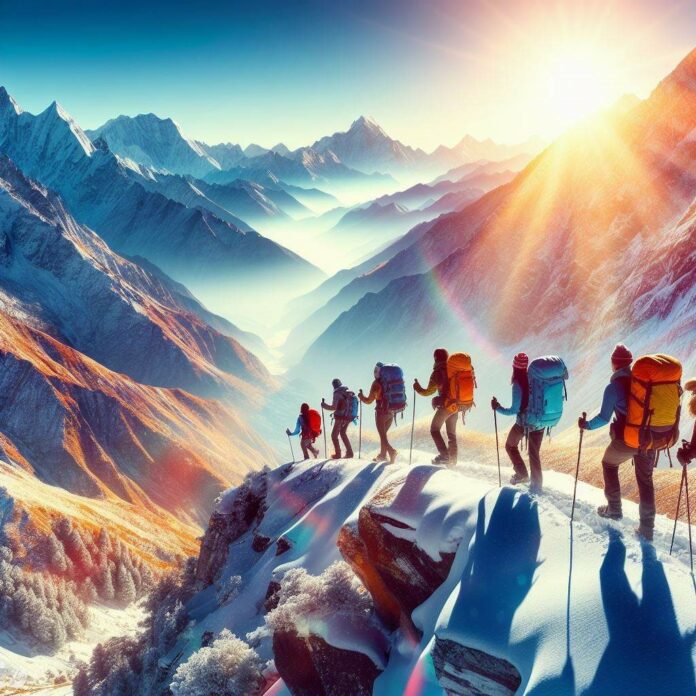Trekking in the Himalayas is a thrilling and rewarding adventure that allows you to immerse yourself in the breathtaking beauty of the world’s highest mountain range. Proper planning is crucial to ensure a safe and successful trekking experience. Here is a comprehensive guide to help you plan a trekking adventure in the Himalayas.
The Himalayas, with their majestic peaks, diverse landscapes, and rich cultural heritage, provide an unparalleled trekking experience. Trekking in this region offers an opportunity to explore remote trails, encounter local communities, and witness stunning natural wonders.
Before embarking on your Himalayan adventure, it is important to choose the right trek that suits your fitness level, preferences, and time constraints. Factors to consider when selecting a trek include difficulty level, altitude, weather conditions, and the availability of facilities along the route.
There are several popular treks in the Himalayas, each offering its own unique charm and challenges. Proper physical fitness and training are essential to ensure you are physically prepared for the demands of trekking in the Himalayas.
Gathering the right gear and equipment, including appropriate clothing, footwear, and camping essentials, is crucial for a comfortable and safe trekking experience. Acclimatization is another vital aspect to consider preventing altitude sickness.
Choosing the Right Trek
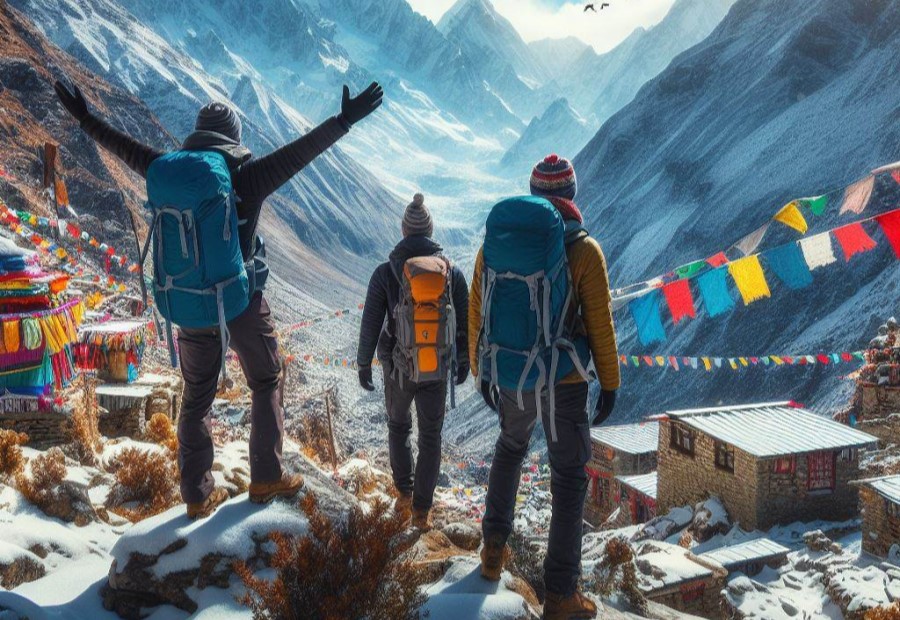
Factors to Consider When Choosing a Trek
When choosing a trek in the Himalayas, there are several factors to consider:
- Physical Fitness: Assess your fitness level and choose a trek that aligns with your abilities. Some treks are more challenging and require a higher level of fitness.
- Difficulty Level: Consider the difficulty level of the trek, including the terrain, altitude, and weather conditions. Choose a trek that matches your experience and comfort level.
- Duration: Determine the length of time you have available for the trek. Some treks can be completed in a few days, while others require several weeks.
- Scenic Beauty: Consider the natural beauty and landscapes you want to experience on your trek. Different treks offer varying scenery, such as breathtaking Himalayan peaks or lush green valleys.
- Altitude: Take note of the maximum altitude reached during the trek. Altitude sickness can be a concern, so choose a trek that allows for proper acclimatization.
- Crowd Levels: Decide whether you prefer a more secluded trek or one that is popular and attracts more travelers. Some treks can be crowded during peak seasons.
Pro-tip: It is essential to do thorough research and consult with experienced trekkers or local guides to ensure that the chosen trek matches your preferences and capabilities.
Preparing for the Trek
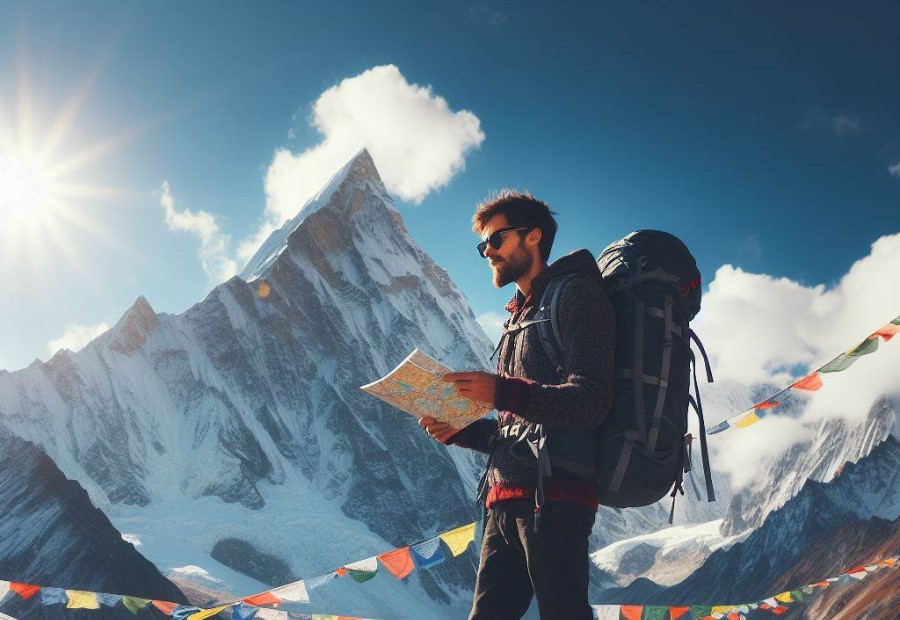
Physical Fitness and Training
To ensure your physical fitness and preparedness for a trekking adventure in the Himalayas, it is important to incorporate both physical fitness and training. Start with cardiovascular exercises such as running or cycling to improve your endurance.
In order to build muscle strength needed for uphill climbs, include strength training exercises like squats, lunges, and push-ups.
Practice hiking on uneven terrain to acclimate your body to the challenges of trekking. It is also important to include flexibility exercises such as yoga or stretching to prevent injuries and improve overall mobility.
Gradually increase the intensity and duration of your training sessions to build up stamina. Remember to listen to your body and avoid overexertion and injuries. Stay hydrated during your training sessions to improve performance and aid in recovery.
Consider consulting with a fitness trainer or professional to create a personalized training plan based on your current fitness level and the specific demands of your chosen trek.
It is important to build up you’re training gradually, taking into account your schedule and allowing for rest and recovery days.
By preparing your body for the challenges ahead, you’ll be able to fully immerse yourself in the breathtaking landscapes and unique adventures that await on your trek in the Himalayas.
Gear and Equipment
When preparing for a trek, it is crucial to have the right gear and equipment. This ensures your safety and comfort during the journey. Some essential gear includes hiking boots, a backpack, waterproof jacket, layered clothing, sun hat, and sunglasses. These will protect you from weather conditions and provide comfort while hiking.
In terms of equipment, having a sleeping bag and tent is vital for a good night’s sleep. Trekking poles aid in stability and reduce the strain on your knees. Carrying a cooking stove and utensils allows you to prepare meals on the trail, while a water bottle helps you stay hydrated. Additionally, a headlamp is necessary for navigating in low-light conditions.
Having the appropriate gear and equipment can contribute to the success and enjoyment of your trek. Remember to choose gear that is suitable for the terrain and weather conditions you will encounter.
Acclimatization
During a trek in the Himalayas, acclimatization is of utmost importance for your safety and well-being. It is crucial to gradually adapt to the increasing altitude in order to avoid altitude sickness.
- Ensure that you plan for regular rest days at higher altitudes to allow your body to adjust to the reduced oxygen levels.
- Stay properly hydrated by drinking plenty of water, as adequate hydration aids in acclimatization.
- Pay attention to your body’s signals and take it slow. Avoid overexerting yourself and allow sufficient time for your body to acclimatize to the altitude.
- Monitor your symptoms closely. If you encounter severe headaches, dizziness, nausea, or breathing difficulties, immediately descend to a lower altitude.
- Gradual ascent can facilitate acclimatization. Aim to increase your sleeping altitude by no more than 300-500 meters per day once you reach 2500 meters above sea level.
- Consider taking medication, such as acetazolamide, that has been prescribed by a healthcare professional, specifically for altitude sickness prevention if advised. However, consult with a doctor prior to commencing any medication.
Remember, acclimatization is indispensable to ensure a secure and enjoyable trekking experience in the Himalayas. Listen to your body, take necessary precautions, and relish the awe-inspiring vistas that await you on your journey.
Planning the Itinerary

Determining the Duration
Determining the duration of a trek in the Himalayas can be crucial in planning a successful adventure. Here are the steps to consider:
- Assess your fitness level and trekking experience.
- Evaluate the difficulty level of the trek and its daily distance.
- Research the average time taken by other trekkers to complete the same route.
- Consider the terrain and elevation changes along the trek.
- Take into account the weather conditions and the availability of daylight hours during your planned trekking season.
- Consult with experienced trekkers or local guides to get insights on the estimated time required for the trek.
- Add buffer days for rest, acclimatization, side trips, or exploration.
- Consider your own preferences and limitations regarding the pace of the trek.
- Factor in the necessary time for permits and logistical arrangements.
- Make a realistic estimation of the duration based on the above considerations.
Determining the duration of your trek is important to ensure a well-planned and enjoyable adventure in the majestic Himalayas.
Mapping the Route
Mapping the route is an essential step in planning a trek in the Himalayas. Here are the steps to follow:
- Research the trekking route by studying maps and guidebooks to understand the terrain, elevation, and landmarks along the way.
- Identify the starting point and endpoint of the trek to determine the overall distance and estimated duration.
- Break down the trek into daily segments, considering the average distance to be covered each day and the availability of accommodations.
- Identify key checkpoints or landmarks along the route to help navigate and track progress.
- Take into account any alternative routes or side trips that you may want to add to the itinerary for additional scenic or cultural experiences.
- Consider the elevation gain and loss throughout the trek to plan for gradual acclimatization and avoid altitude sickness.
- Note the availability of water sources, rest stops, and villages along the route for necessary provisions and restocking.
- Consult with experienced trekkers, local guides, or trekking agencies for recommendations and insights on the best route options.
- Use digital mapping tools or apps to mark waypoints, track your progress, and access offline maps for navigation in areas with limited internet connectivity.
- Create a detailed itinerary and share it with a trusted person who can keep track of your progress and provide assistance if needed.
Identifying Campsites and Accommodations
When planning a trekking adventure in the Himalayas, it is essential to identify suitable campsites and accommodations along the route. This will help ensure a comfortable and safe experience during the trek.
Here are some factors to consider when identifying campsites and accommodations:
- Terrain: Look for flat or gently sloping areas that are ideal for setting up tents. Avoid locations with loose rocks or potential hazards.
- Water source: Make sure the campsite is close to a water source for drinking and cooking. This could be a river, stream, or a nearby water spring.
- Scenic views: Choose campsites that provide beautiful views of the surrounding mountains or valleys. This will enhance the overall trekking experience.
- Proximity to hiking trails: Select campsites that are near the hiking trails you plan to explore. This will save time and energy during the trek.
- Availability of facilities: Check if the campsite offers basic facilities like toilets, showers, and cooking areas. Some campsites may also have guesthouses or lodges for overnight stays.
- Safety: Ensure that the campsite is situated in a safe area, far from potential risks such as landslides or avalanches. Also, consider setting up camp near other trekkers for added safety.
By considering these factors, you can effectively identify suitable campsites and accommodations that meet your needs and ensure a memorable trekking experience in the Himalayas.
Organizing Permits and Permissions
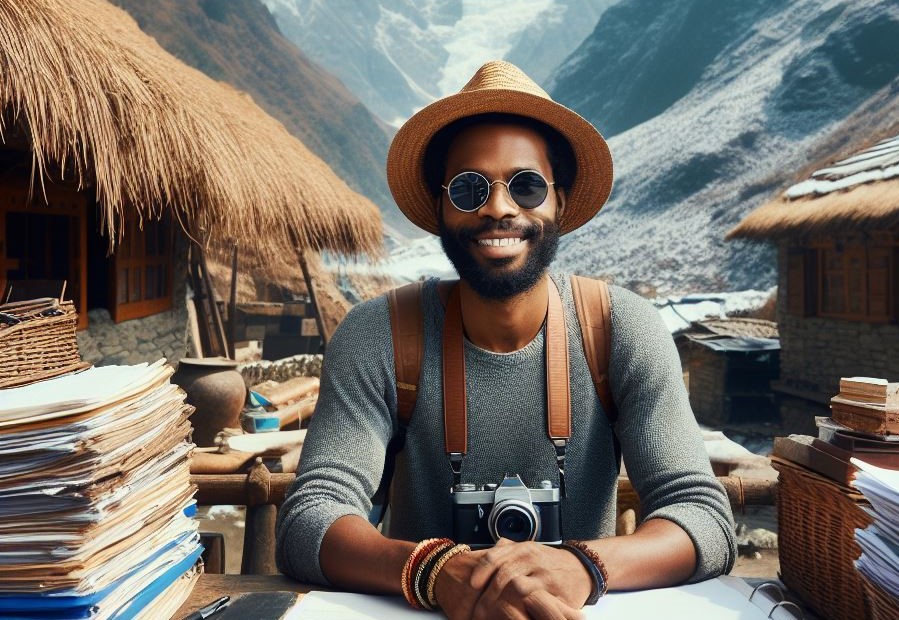
Visa and Travel Documents
When planning a trekking adventure in the Himalayas, it is crucial to obtain the necessary visa and travel documents. One should ensure that all required documents, including the visa and any permits, are valid and up to date.
It is important to check the specific visa requirements for the country you intend to visit in the Himalayas. It is advisable to apply for the visa well in advance, considering the processing time.
Additionally, it is essential to have a valid passport with at least six months of validity remaining. Make sure to thoroughly check the visa restrictions, entry and exit requirements, and any specific permits that may be needed for trekking in certain regions.
To stay informed, regularly check the official website of the embassy or consulate of the country you plan to visit. They will provide accurate and updated information regarding visa application procedures and any travel advisories.
Remember to always carry copies of all important documents, including your passport and visa, while trekking. It is advisable to keep the originals in a safe place and have electronic copies as a backup.
By adhering to the visa and travel document requirements, you can ensure a smooth and hassle-free trekking experience in the breathtaking landscapes of the Himalayas.
Obtaining Trekking Permits
When planning a trekking adventure in the Himalayas, obtaining trekking permits is an essential step that ensures a smooth and legal experience.
Here are some important points to consider:
- Research the specific trekking area and identify the permits required. Each region in the Himalayas may have different permit regulations and requirements.
- Contact the local tourism or trekking authorities to obtain accurate information about the permits and any additional documents needed.
- Fill out the necessary permit application forms accurately and submit them along with any required supporting documents.
- Pay the permit fees as specified by the authorities.
- Obtain the necessary permissions well in advance of your planned trekking dates to avoid any last-minute delays or complications.
- Carry multiple copies of your permits during the trek and ensure they are easily accessible.
- Respect the rules and regulations associated with the permits. Follow the designated routes, do not deviate from the permitted areas, and abide by any restrictions or guidelines imposed by the authorities.
- Be prepared to show your permits at various checkpoints along the trekking route. Failure to present valid permits may result in fines or even being denied access to certain areas.
By following these guidelines and obtaining the necessary trekking permits, you can enjoy your Himalayan trek while ensuring compliance with local regulations and supporting the preservation of the region’s natural beauty.
Choosing a Trekking Agency or Guide

When embarking on a trekking adventure in the Himalayas, one crucial decision is choosing a trekking agency or guide. In this section, we’ll dive into the importance of conducting thorough research and selecting the right agency for your journey.
Additionally, we will explore the array of benefits that arise from hiring a knowledgeable guide to navigate the challenging terrain of the Himalayas. So, let’s set off on this exploration and ensure a safe and memorable trekking experience!
Researching and Selecting an Agency
When planning a trekking adventure in the Himalayas, it is crucial to thoroughly research and select an agency that specializes in the specific requirements of your trek. By researching and selecting an agency, you can ensure a safe and enjoyable experience.
It is important to consider factors such as the agency’s reputation, positive reviews from previous trekkers, their experience in organizing treks, the qualifications of their guides, and the level of customer service they provide.
It is advisable to check if the agency is licensed and registered with the appropriate governing bodies to ensure legal operations. Additionally, look for certifications or affiliations with recognized trekking organizations.
Evaluating the agency’s commitment to responsible and sustainable tourism practices is also crucial, as it reflects their dedication to preserving the environment and supporting local communities.
Benefits of Hiring a Guide
The benefits of hiring a guide for your trekking adventure in the Himalayas are numerous:
- Expertise and Local Knowledge: By hiring a guide, you gain access to their extensive knowledge of the region, its terrain, and its culture. They can provide valuable insights and information about the trek, ensuring a safer and more informed experience.
- Navigation and Route Planning: A guide, with their in-depth familiarity with the trekking routes, can confidently lead you through the trails, ensuring you stay on the right path and avoid getting lost.
- Safety and Emergency Preparedness: Guides, who undergo training in first aid, are well-prepared to handle any emergencies that may arise during the trek. They can provide immediate assistance in case of injuries or altitude sickness.
- Cultural Immersion: A guide can help you connect with the locals, facilitating interactions and giving you insights into the local customs and traditions. They can also assist with language barriers, making your experience more enriching.
- Logistical Support: Guides can take care of arranging accommodations, permits, and transportation, saving you time and effort. They can also help with organizing meals, ensuring you have access to clean and safe food and water.
Packing Essential Items
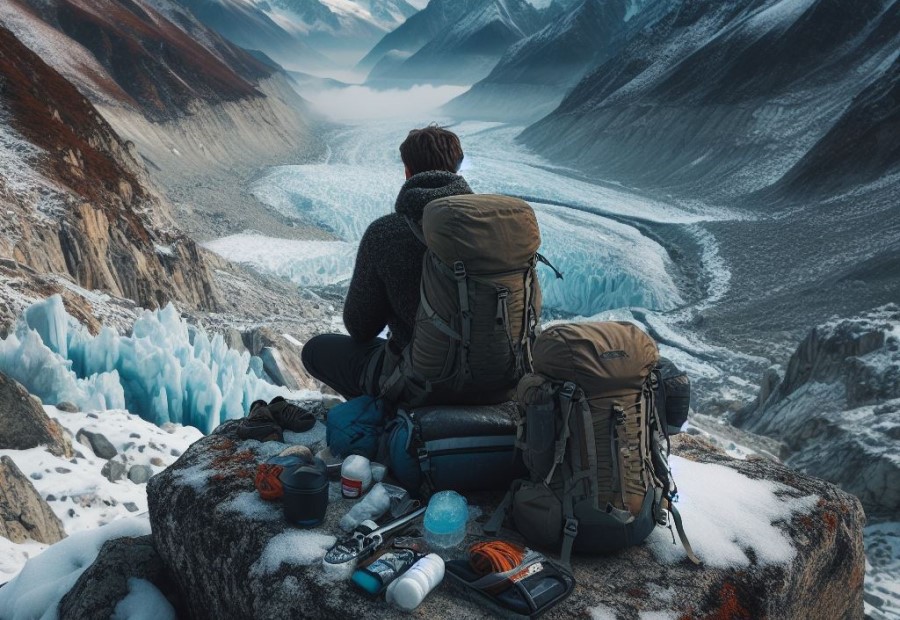
Clothing and Footwear
| Clothing | Footwear |
| When preparing for your trek, it is important to consider the right clothing and footwear options. Layered clothing is essential to cope with changing weather conditions. Start with a moisture-wicking base layer to keep you dry. A lightweight and breathable t-shirt or long-sleeved shirt for comfort. A warm insulating layer like a fleece or down jacket for chilly temperatures. A waterproof and windproof outer shell to protect against rain and strong winds. | Investing in high-quality trekking shoes is crucial to ensure a comfortable and safe experience. Look for footwear that provides ankle support and has a sturdy sole for better grip. It is advisable to break them in before your trek to avoid blisters. Additionally, it is recommended to carry a pair of lightweight and comfortable sandals or flip-flops for relaxation at the campsite and for crossing streams. |
| In terms of clothing, it is important to wear appropriate innerwear and thermal layers for added warmth. Opt for moisture-wicking and quick-drying materials like merino wool or synthetic fabrics. | When it comes to footwear, choose wool or synthetic socks that provide cushioning and moisture-wicking properties. It is also wise to carry extra pairs in case your feet get wet. |
| Avoid using cotton clothing as it tends to retain moisture and takes a long time to dry. This can cause discomfort and increase the risk of hypothermia. | For added protection, consider using gaiters to keep snow, rocks, or debris out of your footwear. |
| To protect your head from the sun, make sure to wear a lightweight and breathable hat or cap. For colder weather, carry a warm beanie or hat. | Considering using trekking poles during your trek will provide stability and reduce strain on your knees and legs. |
| When it comes to clothing, it is crucial to wear gloves or mittens for warmth and protection against the cold. Opt for waterproof and insulated options for high-altitude treks. |
Sleeping Gear and Shelter
When planning a trekking adventure in the Himalayas, choosing the right sleeping gear and shelter is crucial for a comfortable and safe experience. Consider the following options:
- Tent: A lightweight and weather-resistant tent is essential for protection against rain, wind, and cold temperatures. Look for a tent with a sturdy structure and proper ventilation.
- Sleeping Bag: Invest in high-quality sleeping gear and shelter that is suitable for the temperatures you will encounter during your trek. Check the temperature rating of the sleeping bag to ensure it will keep you warm.
- Sleeping Pad: A sleeping pad provides insulation and cushioning between you and the ground. Look for a pad that is lightweight, compact, and offers sufficient comfort.
- Pillow: While not essential, a small inflatable pillow can significantly enhance your sleeping comfort during the trek.
- Emergency Shelter: It’s always wise to carry reliable sleeping gear and shelter, such as a bivy sack or a lightweight tarp. This can serve as a backup in case of unforeseen circumstances.
Food and Water
Here is a table with information about food and water during a trek:
| Aspect | Details |
|---|---|
| Food | Carry lightweight, high-energy food such as trail mix, energy bars, and dehydrated meals. Aim for a daily calorie intake of around 3,500 to 4,500 calories to sustain energy levels during the trek. Include a mix of carbohydrates, proteins, and fats in your meals. |
| Water | Stay hydrated by drinking at least 3-4 liters of water daily. Carry a water bottle or hydration bladder to easily access water along the way. Treat water from natural sources using water purification tablets or filters to prevent waterborne illnesses. |
Pro-tip: To save weight and space, consider using a portable water filter instead of carrying large quantities of water. It allows you to filter water from streams and rivers, ensuring a clean and safe water source throughout your trek.
First Aid Kit and Medications
When planning a trekking adventure in the Himalayas, it’s crucial to prepare a first aid kit and pack necessary medications such as Bandages and adhesive tape for wound care and support, Antiseptic wipes or solution to clean wounds, Gauze pads for dressing larger injuries, Tweezers for removing splinters or foreign objects;
Scissors for cutting bandages or clothing if necessary, Pain relievers such as ibuprofen or acetaminophen, Anti-inflammatory medication for muscle aches or sprains, Antihistamines to relieve allergic reactions or insect bites, Anti-diarrheal medication to manage gastrointestinal issues;
Rehydration salts to replace electrolytes in case of dehydration, Sunscreen and lip balm with SPF for sun protection, Insect repellent to ward off mosquitoes and other bugs, and A compact first aid manual for reference.
It’s essential to customize your first aid kit according to your individual needs and any specific medical conditions. Consult with a healthcare professional for personalized advice on medications that may be necessary during your trek. Remember to check the expiration dates of all medications and replace them if needed.
Staying Safe and Hydrated
When embarking on a trekking adventure in the Himalayas, it is crucial to prioritize staying safe and hydrated. Here are some key points to keep in mind:
- Stay Hydrated: Drinking plenty of water is essential to prevent dehydration and altitude sickness. Aim to consume at least 2-3 liters of water per day to maintain proper hydration levels.
- Ensure Water Purification: While there are natural water sources along the trekking routes, it is important to purify the water before consuming it to avoid waterborne illnesses. Carry water purification tablets or a water filter system.
- Listen to Your Body: Altitude and physical activity can lead to increased fluid loss through sweat and respiration. Monitor the color of your urine – clear or light yellow indicates good hydration, while dark yellow or amber may imply dehydration.
- Take Regular Breaks: Resting and taking breaks while trekking allows your body to recover and rehydrate. Pay attention to your body’s signals and rest when necessary.
- Protect Yourself from the Sun: The Himalayas have intense sun exposure, which can contribute to dehydration. Wear a wide-brimmed hat, use sunscreen, and wear sunglasses to shield yourself from harmful UV rays.
- Beware of Altitude Sickness: Altitude sickness can induce dehydration and other health issues. Stay hydrated and acclimate properly by ascending gradually and giving your body adequate time to adjust to higher altitudes.
- Carry Electrolyte-Rich Snacks: In addition to drinking water, replenish your electrolytes by snacking on foods such as nuts, fruits, and energy bars that contain minerals and salts.
By following these tips, you can ensure your safety and maintain proper hydration throughout your trekking adventure in the Himalayas.
Dealing with Altitude Sickness
Dealing with altitude sickness while trekking in the Himalayas is crucial for a safe and enjoyable experience. Here are some important tips to consider:
- Acclimatize gradually: Ascend slowly to allow your body to adapt to the high altitude. A general rule is to gain no more than 300-500 meters in altitude per day.
- Stay hydrated: Drink plenty of fluids, as dehydration can worsen the symptoms of altitude sickness. Aim for at least 2-3 liters of water per day.
- Take rest days: Plan rest days during your trek to allow your body to adjust to the altitude. These days can also be used for short hikes to higher altitudes and then returning to lower altitudes for sleep.
- Recognize symptoms: Be aware of the symptoms of altitude sickness, which can include headache, dizziness, nausea, fatigue, and difficulty sleeping. If you experience severe symptoms, descend to a lower altitude immediately.
- Consider medication: Consult with a healthcare professional before your trek to discuss the possibility of taking medication such as acetazolamide (Diamox) to prevent altitude sickness.
- Be prepared: Carry a first aid kit that includes medications for altitude sickness, as well as basic supplies for treating other common trekking injuries.
- Listen to your body: Pay attention to how you feel and communicate any concerns or symptoms to your trekking companions or guide.
Remember, dealing with altitude sickness is crucial while trekking in the Himalayas. Altitude sickness can affect anyone, regardless of fitness level or experience. It’s important to prioritize your safety and well-being during your trek in the Himalayas.
Capturing the Memories
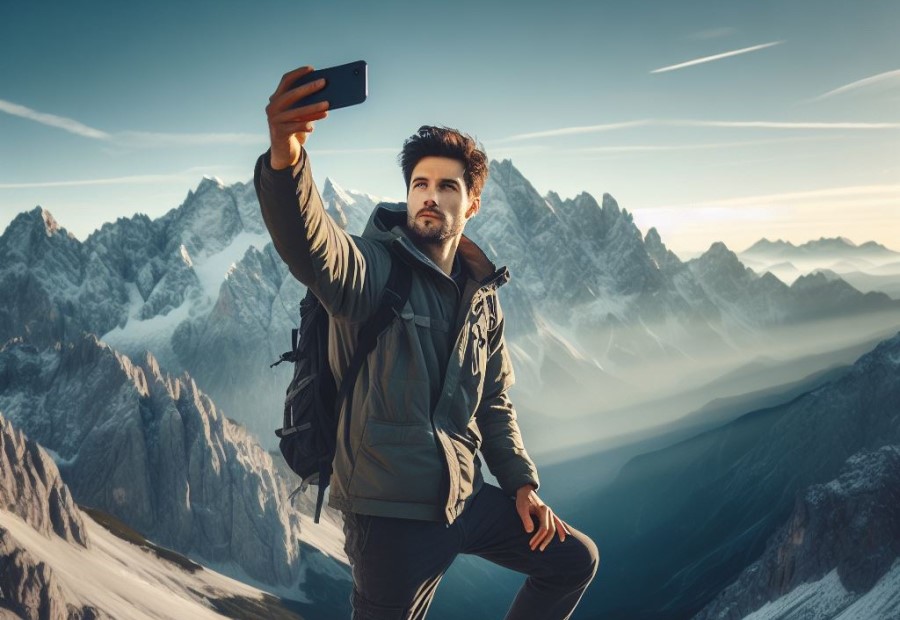
Photography Tips
- Choose the right equipment: Invest in a good camera with manual settings to have more control over your photos. A DSLR or mirrorless camera is recommended for its versatility and image quality.
- Understand lighting: Lighting plays a crucial role in photography. Learn to utilize natural light to your advantage. Golden hour, which is the hour after sunrise or before sunset, provides beautiful soft light for stunning landscape shots.
- Compose your shots: Pay attention to the composition of your images. Use the rule of thirds, leading lines, and different perspectives to create visually appealing photographs.
- Capture the details: Don’t just focus on wide-angle shots. Experiment with close-up shots to capture the intricate details of nature, such as the texture of rocks or the colors of flowers.
- Experiment with different settings: Don’t be afraid to try out different camera settings to achieve different effects. Adjust your aperture to control depth of field or use a slow shutter speed to capture motion blur in waterfalls.
Remember, practice makes perfect. Take your time to explore and experiment with your camera settings to develop your photography skills. Capturing the beauty of the Himalayas through your lens will allow you to relive your trekking adventure for years to come.
Keeping a Trekking Journal
Keeping a trekking journal is a valuable way to document and preserve your memories of your adventure in the Himalayas. Here are the steps to take:
- Carry a waterproof journal or notebook specifically for your trek.
- Write daily entries, detailing the highlights, challenges, and experiences of each day.
- Include information on the places you visit, the people you meet, and the unique moments you encounter.
- Jot down any interesting flora, fauna, or landscapes you come across.
- Record your reflections and emotions, capturing your thoughts and feelings throughout the journey.
- Use descriptive language to paint a vivid picture of your experiences.
- Include any photographs or sketches that you may want to reference later.
- Mention the weather conditions and any noteworthy events that occur.
- Document the distances you cover each day and any achievements or milestones you reach.
By keeping a trekking journal, you can reflect on your adventure and relive the moments even long after the trek is over. It serves as a personal keepsake and a way to share your experiences with others.
Frequently Asked Questions
How should I plan a trekking adventure in the Himalayas at an entry level?
When planning a trekking adventure in the Himalayas at an entry level, it is important to consider your physical fitness, time constraints, and budget. Start with a hike that matches your level of trekking experience and fitness level. Choose a trek that suits your interests and ideal season.
Consider the level of difficulty of each trek and be realistic about your abilities. If you have children, ensure the trek has pony or porter support or is suitable for them. Also, consider the number of trekking days and the time it takes to get to and from the starting point.
Is it necessary to talk with someone who has experience trekking in the Himalayas before planning a trip?
Yes, it is highly recommended to talk to someone who has experience trekking in the Himalayas before planning your trip. They can provide valuable first-hand information about the trekking routes, trail conditions, weather patterns, and cultural landmarks. Their knowledge and experience can help you plan a safe and memorable journey.
What are some pro tips for planning and executing a trekking adventure in the Himalayas?
– Start by researching the trekking route or region to understand trail conditions, weather patterns, and cultural landmarks.
– Consider booking through a reputable trekking tour operator for logistical support.
– Visit a doctor before the trek and consider getting travel cum medical insurance.
– Arrange necessary permits and documents, including a medical fitness certificate if required.
– Get fit for the trek by starting a fitness program and doing practice hikes.
– Check the list of things to carry, including clothing, sleeping bag, trekking shoes, and a backpack.
– Pack smart and light to avoid carrying unnecessary items.
– Budget your expenses for the trek, including tour package cost, travel, gear, and personal expenses.
– Don’t jump into a trek at the last moment, plan well in advance.
– Stay hydrated and eat sufficient food during the trek.
– Acclimatize properly to the high altitude by sleeping inside the tree line for three nights before reaching higher altitudes.
– Be aware of the symptoms of Acute Mountain Sickness (AMS) and take immediate action if affected.
– Avoid alcohol and smoking on the mountain.
– Cool down at the campsite before resting in the tent.
What are some popular trekking periods and destinations in the Himalayas?
The best time to trek in most parts of the Himalayas is in April and October, although some areas in the west have better weather in July and August. Popular trekking destinations include Ladakh in India, Tibet, Nepal, and Bhutan.
These regions offer diverse landscapes, cultural experiences, and trekking options suitable for different trekking grades and preferences.
Is it safe to trek in the Himalayas and what precautions should I take?
While trekking in the Himalayas can be adventurous, it is important to take necessary precautions to ensure safety. Staying healthy in the Himalayas can be challenging, so it is advised to be cautious about altitude and hygiene. It is crucial to acclimatize properly to the high altitude and be aware of the symptoms of Acute Mountain Sickness (AMS).
Additionally, it is recommended to stay hydrated, eat sufficient food, and avoid alcohol and smoking on the mountain. Following the natural rules and guidelines, such as staying on marked trails and respecting the local culture, will contribute to a safe and enjoyable trekking experience.
What are some alternative trekking destinations in the Himalayas?
For those seeking alternative trekking destinations in the Himalayas, Spiti in Himachal Pradesh offers dramatic mountain scenery without the crowds. Mustang in Nepal features centuries-old Tibetan architecture and a unique high altitude desert landscape.
These less explored regions provide an opportunity to experience the alpine wilderness and immerse in the nature’s grandeur in a more tranquil setting.

